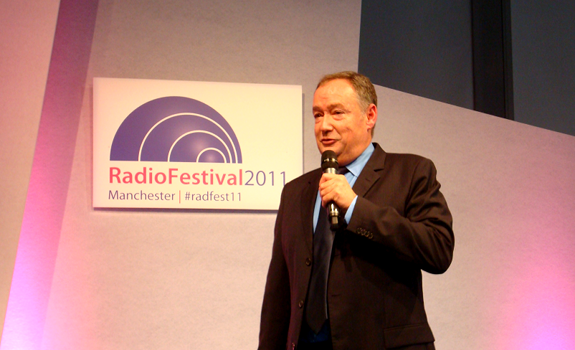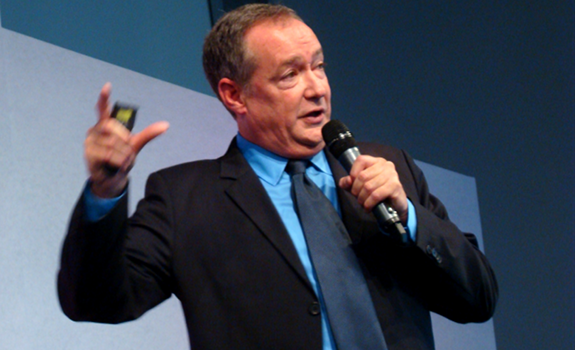Jingles in between songs are not a tune-out, says radio strategist Dennis Clark. If well produced, station imaging enhances on-air branding and listening experience.
In the light of some German stations that have been reducing sound design, I was interested in PPM (and other research) findings about the effect of using radio production like jingles, sweepers and promos on air. I discussed it with Clear Channel radio executive Dennis Clark, who did a lot of audience research for stations like 102.7 KIIS FM and Z100.
“Station imaging should not sound like a commercial”
Radio branding vs. potential tune-out
During the radio programming part of his presentation at the Radio Festival, Dennis Clark stressed the importance of being the number 1 choice of your target audience. In PPM-language: being people’s base station. He emphasized that radio listeners need to remember your brand name and dial position. It seems to me that sound design is one of the best ways to constantly communicate this on the air. But what about the fact that any transition is a potential tune-out? And what about arguments for minimalistic radio production – like ‘it disturbs the music flow’ or ‘listeners are fed up with radio’s self-promotion’?

Clear Channel radio executive Dennis Clark speaks at the Radio Festival 2011 in Manchester (photo: Thomas Giger)
In your session, you talked about creating smooth transitions to keep people listening; to avoid them tuning out when a new program element starts. What does it mean for radio imaging – especially in between songs?
“This is a very good question. If radio imaging is interesting – if it’s well written and well produced – it actually holds listeners through 30-35 seconds. That’s kind of the limit on any piece we do. The transition between songs while using imaging is not a major tune-out. But we’re finding that we’re losing a couple of people if they hear ‘another commercial’. I guess it’s subconscious that they’re hearing ‘commercials’. Therefore, station imaging should not sound like a commercial; it should sound like a song.”
“Radio imaging is part of the listener experience”
 What about playing (sung) jingles in between songs?
What about playing (sung) jingles in between songs?
“Jingles are fine; they’re part of the radio brand. Station IDs are not on our radar of tune-out problems; they’re part of the transitions. People are used to jingles if they’re heavy listeners. They will listen for the next song. It is the next song that they may not like, or the next event – a series of commercials or a promo, conversation, listener phone call, contest; whatever it may be. These are risky transitions.”
Did you research jingles and imaging in an Auditorium Music Test?
“We have in the past. There are some things that you can test, like the style, pace, tempo, and quality of a variety of different voices. It is interesting to learn if listeners like one versus the other. But it’s a taste test, and these kind of things I’d rather keep simple. We don’t do massive amounts of testing this on KIIS-FM or Z100. We believe that radio imaging is part of the listener experience that they’re used to.”
“Production is the essence of your brand”

Dennis Clark says that jingles are not a tune-out, as long as they blend in with the songs (photo: Thomas Giger)
Some radio stations in Germany minimized their on-air sound design because they assume that listeners can’t be bothered with many self-promotions, contests and advertising anymore. Others assume that production elements interrupt the music flow. What’s your opinion?
“I really believe in production. It’s the texture; the style; the essence of your brand. If you have a constant – which is production – and if it’s good and respected by your listeners, it works. In that case in Germany, they might have some intel that I’m not aware of. But to my knowledge, radio production enhances the experience for the listener.”
 Change perception of over-promotion
Change perception of over-promotion
A German PD who currently keeps his station’s on-air imaging to the absolute minimum, explained to me that listeners feel like todays radio stations have too much advertising and promotions. Another source told me, this station used to ‘jingle’ a lot. It made me think of Bill Drake (photo) with his Boss Radio format; jingle, song, jingle, song. I can understand the German station’s point about radio’s over-promotion. So my question for Dennis Clark was:
What’s the best way of imaging your station, without annoying your listener?
“You know what? I said in my session (about Portable People Meter radio programming) that it’s important to train your listeners on how to use your radio station and show. If you say what you’ve got on your menu in a very conversational, up-tempo and real way, that’s fantastic. But not in a very game show; plastic, rigid way. I think that’s the advertising that might be chasing listeners away in Germany.”
Read also:
- PPM: Radio Programming For Heavy Listeners
- Sound Design: ‘Do Not Disturb Please’
- Production (related articles)
Stay tuned, follow us: @RadioILOVEIT





Add Your Comment